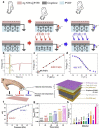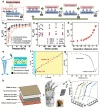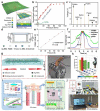Triboelectric Nanogenerators as Active Tactile Stimulators for Multifunctional Sensing and Artificial Synapses
- PMID: 35161721
- PMCID: PMC8840436
- DOI: 10.3390/s22030975
Triboelectric Nanogenerators as Active Tactile Stimulators for Multifunctional Sensing and Artificial Synapses
Abstract
The wearable tactile sensors have attracted great attention in the fields of intelligent robots, healthcare monitors and human-machine interactions. To create active tactile sensors that can directly generate electrical signals in response to stimuli from the surrounding environment is of great significance. Triboelectric nanogenerators (TENGs) have the advantages of high sensitivity, fast response speed and low cost that can convert any type of mechanical motion in the surrounding environment into electrical signals, which provides an effective strategy to design the self-powered active tactile sensors. Here, an overview of the development in TENGs as tactile stimulators for multifunctional sensing and artificial synapses is systematically introduced. Firstly, the applications of TENGs as tactile stimulators in pressure, temperature, proximity sensing, and object recognition are introduced in detail. Then, the research progress of TENGs as tactile stimulators for artificial synapses is emphatically introduced, which is mainly reflected in the electrolyte-gate synaptic transistors, optoelectronic synaptic transistors, floating-gate synaptic transistors, reduced graphene oxides-based artificial synapse, and integrated circuit-based artificial synapse and nervous systems. Finally, the challenges of TENGs as tactile stimulators for multifunctional sensing and artificial synapses in practical applications are summarized, and the future development prospects are expected.
Keywords: active tactile stimulators; artificial synapses; multifunctional sensing; triboelectric nanogenerators.
Conflict of interest statement
The authors declare no conflict of interest.
Figures












Similar articles
-
Gel-Based Triboelectric Nanogenerators for Flexible Sensing: Principles, Properties, and Applications.Nanomicro Lett. 2024 May 31;16(1):206. doi: 10.1007/s40820-024-01432-2. Nanomicro Lett. 2024. PMID: 38819527 Free PMC article. Review.
-
Recent Advances in Flexible Tactile Sensors for Intelligent Systems.Sensors (Basel). 2021 Aug 10;21(16):5392. doi: 10.3390/s21165392. Sensors (Basel). 2021. PMID: 34450833 Free PMC article. Review.
-
Recent Progress in Self-Healing Triboelectric Nanogenerators for Artificial Skins.Biosensors (Basel). 2025 Jan 10;15(1):37. doi: 10.3390/bios15010037. Biosensors (Basel). 2025. PMID: 39852088 Free PMC article. Review.
-
From Dual-Mode Triboelectric Nanogenerator to Smart Tactile Sensor: A Multiplexing Design.ACS Nano. 2017 Apr 25;11(4):3950-3956. doi: 10.1021/acsnano.7b00396. Epub 2017 Mar 23. ACS Nano. 2017. PMID: 28332823
-
Multidimensional Force Sensors Based on Triboelectric Nanogenerators for Electronic Skin.ACS Appl Mater Interfaces. 2021 Dec 1;13(47):56320-56328. doi: 10.1021/acsami.1c17506. Epub 2021 Nov 16. ACS Appl Mater Interfaces. 2021. PMID: 34783538
Cited by
-
A Flexible Tribotronic Artificial Synapse with Bioinspired Neurosensory Behavior.Nanomicro Lett. 2022 Dec 29;15(1):18. doi: 10.1007/s40820-022-00989-0. Nanomicro Lett. 2022. PMID: 36580114 Free PMC article.
-
Emerging Functional Polymer Composites for Tactile Sensing.Materials (Basel). 2023 Jun 11;16(12):4310. doi: 10.3390/ma16124310. Materials (Basel). 2023. PMID: 37374494 Free PMC article. Review.
References
-
- Wan Y., Wang Y., Guo C.F. Recent progresses on flexible tactile sensors. Mater. Today Phys. 2017;1:61–73. doi: 10.1016/j.mtphys.2017.06.002. - DOI
Publication types
MeSH terms
Grants and funding
- 51922023, 61874011/National Natural Science Foundation of China
- 2021M703159/China Postdoctoral Science Foundation
- 2016YFA0202704/National Key Research and Development Program of China
- 2017000021223TD04/Beijing Talents Foundation
- SKLTKF19B02/Tribology Science Fund of State Key Laboratory of Tribology
LinkOut - more resources
Full Text Sources

